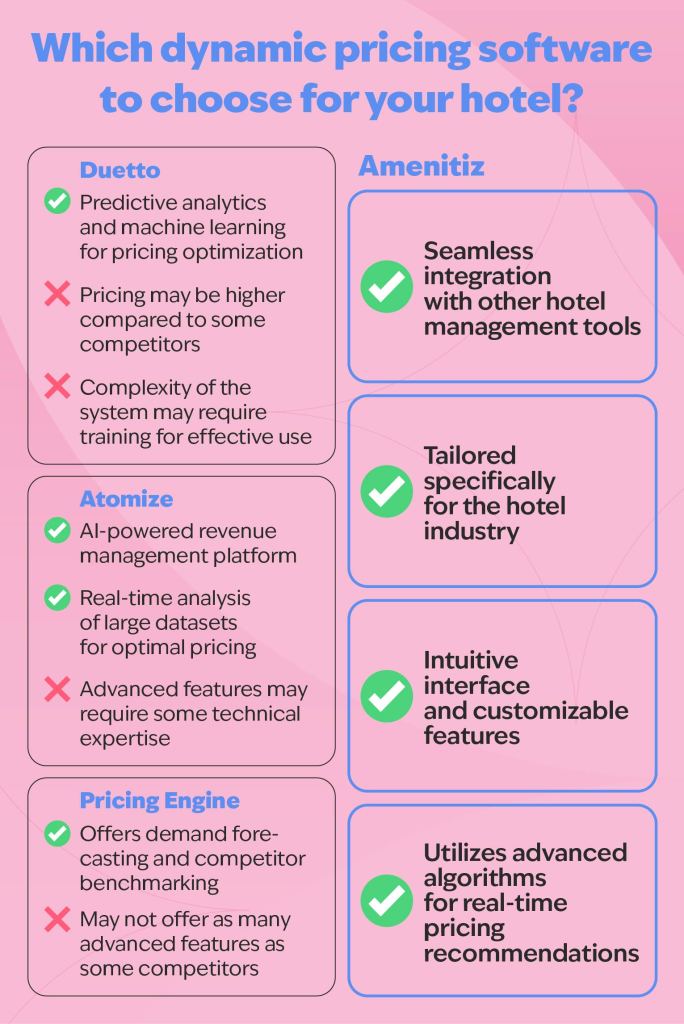
Are you ready to move away from static room rates and turn to a more flexible, revenue-optimizing solution? Whether you’re a property owner, property manager, or full-fledged hotelier, beginners and experts alike, welcome to the fascinating world of hotel dynamic pricing.
Buckle up, because we’re about to take you on an incredible journey from understanding dynamic pricing to choosing the perfect software for your property. I even prepared a comparison of some of the main dynamic hotel pricing tools out there!
- The Rise of Dynamic Pricing in the Hotel Industry
- Dynamic Pricing Demystified: How It Works
- The Critical Role of Dynamic Pricing Software
- Benefits of Dynamic Pricing Software
- Things to Consider When Choosing the Best Dynamic Pricing Software
- Small vs. Large Properties: One Size does Not Fit All
- FAQ
- Keeping an Eye on the Competition
- 5 Dynamic Pricing Software You Should Consider
- FAQ
The Rise of Dynamic Pricing in the Hotel Industry
The hotel industry is known for its volatility. External factors like macroeconomic conditions, local events, and even a volatile weather forecast can cause drastic fluctuation in room demand. Static room rates are no longer the order of the day. That’s why more and more hoteliers are implementing dynamic pricing.
After all, the hospitality sector is constantly evolving and to keep up with both the competition and market trends you need to adjust your room rates often. However, it can be incredibly time consuming to try and stay on top of all those price changes. This is why an adaptable pricing tool can really make a difference and allow you to strategise thanks to efficient data analysis and easy access to historical data.
Dynamic Pricing Demystified: How It Works
How does dynamic pricing work anyway? The key is “demand-based pricing”. The price adjusts automatically, depending on market demand and competition data monitoring. Increasing room prices when demand is high and lowering them when it’s low, allows hotels to maximise revenue and attain optimum occupancy.
Dynamic pricing allow you to adapt your pricing strategies depending on customer behaviour. You need to be extremely flexible with your rates in order to find the optimal prices at the right moment without compromising your occupancy rates. Dynamic rates can help you face sudden market changes and take informed decisions to maximise profit.
The Critical Role of Dynamic Pricing Software
Managing fluctuating rates manually is not a feasible option. Here’s where a good dynamic pricing software comes into play. It’s a cloud-based solution enabling real-time market data monitoring, data analysis, and price adjustment to ensure optimal profitability. The software automates the process, freeing up your time for more pressing tasks.
Whether you manage independent hotels or medium sized hotels, you need to ensure your pricing information is always up to date. You can’t have a fixed price because things will change around you (events, weather, competition) and your prices need to reflect what is actually going on. A hotel pricing software will not prevent you from setting minimum and maximum prices or offer a custom package to you guest. However it will allow you to adapt your pricing directly for the week trends. And that is something that can change the game.
Benefits of Dynamic Pricing Software
Beyond automating the adjusting of room rates, notable benefits of these tools include a higher revenue potential, mastering market trends, automated monitoring of competitor pricing, and less time spent on manual tasks. Imagine being able to mark-up your room prices during significant local events automatically – that’s dynamic pricing software working for you.
A good software will also take into account both market conditions and your occupancy rates. A good tip would be to ensure your software can be connected to your Channel Manager so you won’t need to adjust prices manually on every OTAs. You hotel can really benefit from dynamic pricing strategies, and not everyone can afford to hire revenue managers to help them out.
After allm revenue management is an integral part of property management and to increase room revenue you need to polish your revenue strategies. Understanding hotel dynamic pricing can go a long way to help you maximise revenue and keep your hotel rooms filled.
Things to Consider When Choosing the Best Dynamic Pricing Software
Every hotelier has unique needs, and the pricing software needs to cater to those needs. When choosing the best dynamic pricing software, consider features such as ease of use, real-time market insights, pricing details, affordability, seamless integration with your existing property management system, and last but not least, excellent customer support.
Some things can be useful to enable you to make informed decisions like:
-
a direct connection to your booking engine or channel manager
-
several pricing options
-
being a cloud based software
-
revenue potential
-
easy preview market insights
-
automatic price adjustment, etc.
Small vs. Large Properties: One Size does Not Fit All
When it comes to dynamic hotel pricing, the size of the property matters. Small properties need a revenue management system that is straightforward, efficient, and affordable. For them, we suggest PriceAdvisor by Amenitiz. For large properties, a business intelligence tool that incorporates advanced features and ultimate customization capabilities is crucial.
The most important thing to consider is that, whatever tool you’ll be choosing you need to take your needs into account. You may have different expectations or your goal might differ, but for your pricing management system to be effective, it needs to be tailored to your needs.
Keeping an Eye on the Competition
It’s easy to underprice or overprice your rooms if you’re not aware of your competitors’ rates. An excellent hotel dynamic pricing software should provide a comprehensive competitive analysis to help you stay at par or lead in terms of competitive pricing.
To boost bookings and boost revenue you need to keep a close eye on what your competitors are doing. Staying attractive, pricing wise is an essential thing to keep up with the market trends.
5 Dynamic Pricing Software You Should Consider
Not sure where to start? Don’t fret! We’ve got you covered with a thorough comparison of the top 5 best hotel pricing software available on the market, backed up by reviews and success stories from real users.
The hospitality industry is in flux and looks set to remain so for the near future. As hotel owners, having a steadfast hotel dynamic pricing software like PriceAdvisor by Amentiz by your side can be a game-changer. By choosing the right tool, you’re not just buying a software, but securing an efficient and profitable future.
Here are 5 pricing software to know:
Amenitiz:
-
Comprehensive hotel management platform.
-
Utilizes advanced algorithms for real-time pricing recommendations.
-
Intuitive interface and customizable features.
-
Direct link to OTAs, Channel Manage and PMS
-
Tailored specifically for the hotel industry.
-
Seamless integration with other hotel management tools.
Duetto:
-
Cloud-based revenue management system.
-
Predictive analytics and machine learning for pricing optimization.
-
Pricing may be higher compared to some competitors.
-
Complexity of the system may require training for effective use.
Ideas Revenue Management:
-
Algorithms for market trend analysis.
-
Customizable pricing rules and automated recommendations.
-
Pricing may be higher for smaller hotel operations.
-
Requires a certain level of expertise to fully leverage its capabilities.
Atomize:
-
AI-powered revenue management platform.
-
Real-time analysis of large datasets for optimal pricing.
-
Pricing may not be suitable for all budget levels.
-
Advanced features may require some technical expertise.
Pricing Engine:
-
Offers demand forecasting and competitor benchmarking.
-
Enables hoteliers to make informed pricing decisions.
-
Pricing plans may vary based on the level of features required.
-
May not offer as many advanced features as some competitors.
Each dynamic pricing tool has its own set of advantages and disadvantages, and hoteliers should carefully consider their specific needs, budget, and technical capabilities when choosing the right solution for their property.

FAQ
How do hotels implement dynamic pricing?
Hotels implement dynamic pricing through the use of sophisticated software and algorithms that analyze various factors such as demand, competitor pricing, seasonality, and historical booking data. These factors are continuously monitored and assessed to determine the optimal room rates in real-time. Hoteliers can adjust prices accordingly based on market conditions, consumer behavior, and other influencing factors to maximize revenue and occupancy rates.
What are the different dynamic pricing software out there?
There are several dynamic pricing software solutions available in the market catering to the hospitality industry. Some popular options include:
-
Amenitiz
-
Duetto
-
Ideas Revenue Management
-
Atomize
-
Pricing Engine
-
Revinate
How do you create a dynamic pricing model?
Creating a dynamic pricing model involves several key steps:
-
Data Collection: Gather relevant data such as historical booking information, market trends, competitor pricing, and demand forecasts.
-
Analysis: Utilize analytical tools and algorithms to analyze the collected data and identify patterns, trends, and demand fluctuations.
-
Factors Consideration: Take into account various factors influencing decisions such as seasonality, events, consumer behavior, and inventory levels.
-
Algorithm Development: Develop or utilize algorithms that can dynamically adjust your prices based on real-time data inputs and predefined rules or parameters.
-
Testing and Optimization: Test the dynamic pricing model in different scenarios and continuously optimize it based on performance metrics such as revenue per available room (RevPAR), occupancy rates, and average daily rate (ADR).
-
Implementation: Integrate the dynamic pricing model into existing revenue management systems or utilize specialized software solutions to automate pricing adjustments and ensure seamless implementation across distribution channels.
With a proper understanding of dynamic pricing, and a comprehensive pricing software in place, salient management of market fluctuations, real-time pricing decisions, and increased revenue is more achievable than ever before.